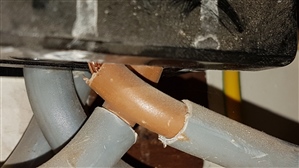Sparkingchip:
I do need to urge to to be very careful if you are going to try and manhandle these tails back into the consumer unit enclosure.
It is not at all unusual to find that the person who stripped the sheath back ran a very sharp knife around the cable and sliced into the inner insulation. You really need to check that the inner insulation is sound at the point the sheath ends.
Personally I only strip sufficient sheath to allow the termination of the cable into the main switch, usually 10 mm or less, I cannot understand why some people strip the sheath right back within the enclosure removing the mechanical protection from the insulation for no apparent reason.
Lucky it’s pretty rare method of install of tails, but I was thinking why the outer sheath had been removed so far back. Perhaps the entry hole with the grommet was to small? At least we can now see why tail glands are such a good idea.


Sparkingchip:
Personally I only strip sufficient sheath to allow the termination of the cable into the main switch, usually 10 mm or less, I cannot understand why some people strip the sheath right back within the enclosure removing the mechanical protection from the insulation for no apparent reason.
mapj1:
It is quite common to have a flash of colour on show for the last cm or so with the grey tails cut slightly short to identify the polarity of the core within.
Not really the way to do it, and personally I prefer a turn of the correct coloured tape, but I am not everyone.
We're about to take you to the IET registration website. Don't worry though, you'll be sent straight back to the community after completing the registration.
Continue to the IET registration site